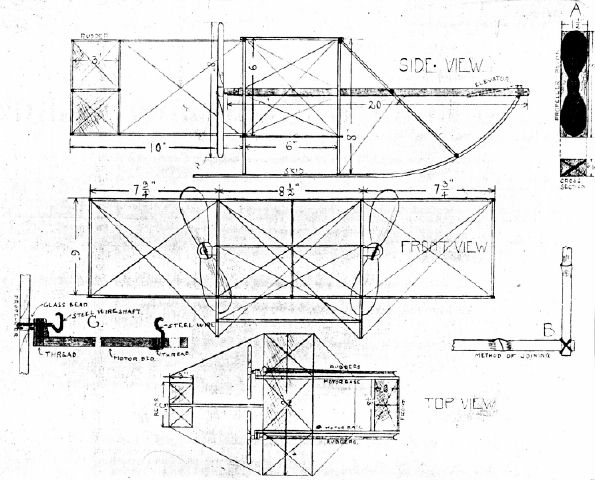|
Construction
of a Wright Model
by Philip McCutcheon
Aeroplane models, like the larger machines, have become
very popular in the last few years, and the demand for comprehensive,
non-technical plans for building these small "aeros" has been
steadily on the increase.
The following paragraphs contain complete directions for
the construction of a model biplane that has been made to resemble the
large Wright machine as far as possible. Of course, certain modifications
have to be made to suit the requirements of a model. The main planes
[wings] of this flyer measure 2 feet by 6 inches, and the frames are made
of strip bamboo 1/8 inch thick by 3/16 inch wide1. The
joints are tightly wrapped with heavy white basting cotton2
and coated with glue, as illustrated in drawing "B."

There are eight vertical struts connecting the main planes; four central
struts made of 1/8-inch dowel, used to support the motor bases, and four
bamboo struts, one for each corner, at the end of the planes. The four
motor-bed struts extend 2 inches down below, the lower plane, providing
attachment for the bamboo skids. The front plane, or "elevator,"
is attached directly to the forward ends of the two motor bases. This
control should be made adjustable, to obtain the proper flying angle, by
experimenting. The rudder and fixed stabilizer are made of 1/8-inch
bamboo, and need not be made adjustable. A good grade of lightweight
muslin3 makes an excellent covering for the planes. The
fabric may either be glued or sewn to the frame.
The motive power for running this flyer is derived from
two rubber-band motors, driving two 8-inch propellers independently in
opposite directions, to avoid gyroscopic action. This necessitates the
turns of the propellers being counted, so as to make sure that both
propellers make the same number of revolutions. This model has wonderful
lateral stability, on account of the absence of propeller torque, which
tends to tilt the plane. The motor bases are 1/4- x 3/8-inch cross section
and are 20 inches in length. Yellow pine or spruce will do nicely for
these.
In making the propellers4, select a
piece of spruce or white pine 8 x 1-1/2 inches and 3/4 inch in
thickness. On the broad face of the wood draw the outline of your
propeller, and on each end draw a line diagonally from one corner to the
other, as shown in drawing "A." This will give the proper pitch
to the blades. Be sure to make the propellers opposite in pitch, so that
they will drive ahead, turning in different directions.
A piece of steel wire5 should be used
for a propeller shaft. Bend a hook, shaped like the one at C, on one end,
and pass the other end through a hole drilled to accommodate it in the
bearing block. Then insert a glass bead6 and a metal
washer of some sort, preferably copper or brass, and put on the propeller,
allowing about 1/2 inch of the shaft to extend beyond the hub. Bend this
end around in a half-circle, and drill a small hole in the hub to
accommodate it and drive the end in, thus locking the shaft to the
propeller.
To provide attachment for the rubber bands at the other
end of the motor base, make another hook and drive the free end through a
hole drilled in the wood, and bend about 1/2 inch of it over against the
stick. To make it more secure, wrap the end to the stick with cotton.
Proper rubber bands can be obtained from any model supply house.
No. 12 music wire7 is about the best
for trussing this model although a heavy grade of shoe thread will do.
Now, suppose you have finished your machine and are
taking it to an open lot for the first tryout: First, wind each propeller
about 150 times, counting carefully, other-wise one propeller will turn
faster than the other, tending to slew the model around when in flight.
When you have finished winding the propellers, hold the machine by the
blades and shove it gently forward. If the elevator is properly adjusted,
the machine will rise gradually and sail for a distance of about 100 feet,
and land easily on the skids.
|

Flyer Side View.

Flyer Front View.

Flyer Top View.

Flyer Prop Detail "A."

Flyer Motor Detail

Flyer Construction Detail "B."
|
![]()
![]()